As en primeur 2018 picks up pace, we consider the 10 Bordeaux wines that any fine wine collector should acquire for their collection. These are based on the results of Wine Lister’s latest Founding Member survey, gathering the views of over 50 key players in the global fine wine trade.
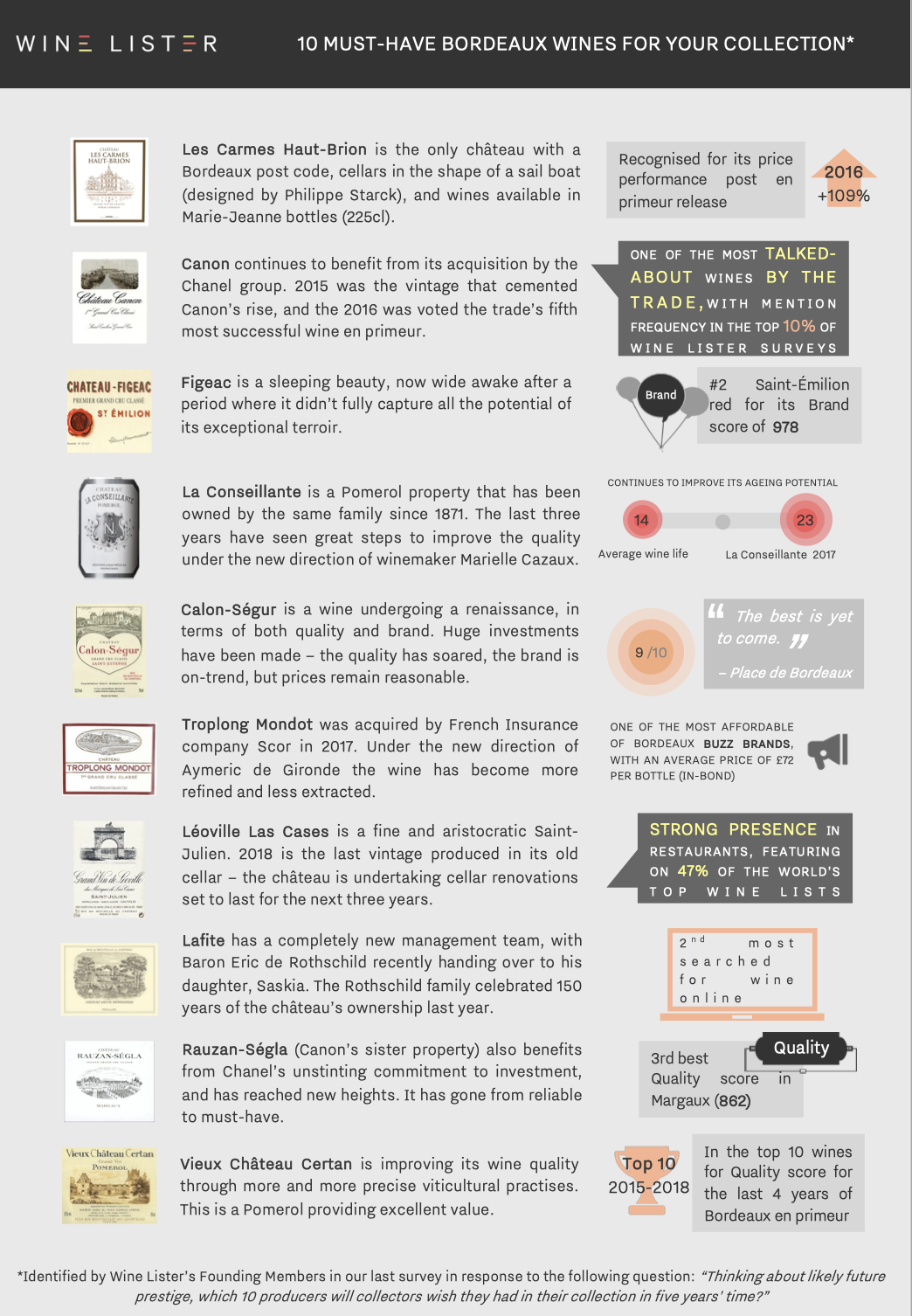
You can download this slide here: 10 must have Bordeaux wines for your collection
In Bordeaux, 2018 was a winemakers’ vintage. That much is clear from conversations the Wine Lister team had throughout en primeur tasting week, explained further in Bordeaux 2018 en primeur part I : the vintage. Though quality across the board was good in 2018, the greats stand out all the more for being the result of key technical decisions, rather than just terroir.
Below we look at the top 25 Bordeaux 2018 red Quality scores, based on the recently-released ratings of Wine Lister partner critics Bettane+Desseauve, Julia Harding for Jancis Robinson, Antonio Galloni for Vinous, and Jeannie Cho Lee. The average Quality score of these top 25 is 975, 25 points higher than the equivalent top red panel in 2017.
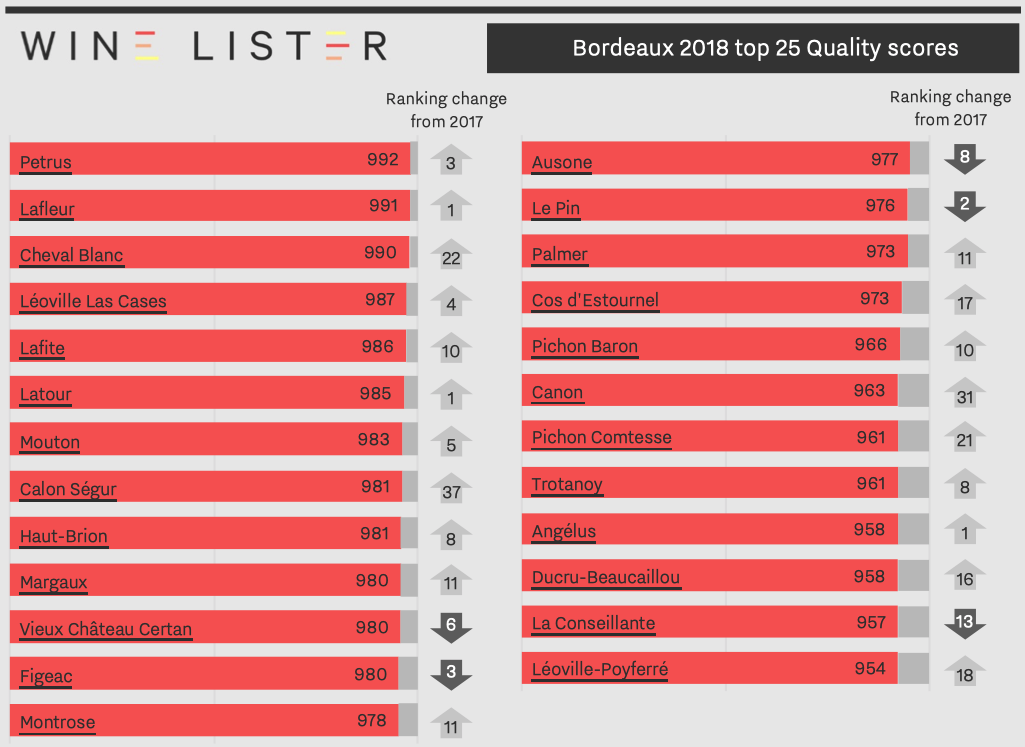
Right bank super-appellation, Pomerol earns the highest number of places in the top 25 red Quality scores (6), and includes the first- and second-best wines of the vintage, Petrus and Lafleur. They earn Quality scores of 992 and 991 respectively, and the former is awarded 97-100 points by Wine Lister partner critic, Antonio Galloni, who comments, “From the very first taste, the 2018 Petrus is simply magical”.
Proving the potential for high quality across both banks in Bordeaux 2018, the next highest appellations are Pauillac and Saint-Émilion with 5 wines appearing in the top 25 apiece. Pauillac wins out overall, with an average score of 976 (vs. 974 in Saint-Émilion). Cheval Blanc (990) and Canon (963) show impressive Quality improvements on 2017, moving 22 and 31 places up the rankings respectively.
Pauillac’s top quality wines are made up, perhaps unsurprisingly, of the three Pauillacais first growths, Lafite (986), Latour (985), and Mouton (983), and super-seconds Pichon Baron and Pichon Comtesse. This last is holds the appellation’s most-improved ranking, moving up 21 places from its 2017 position. Julia Harding of JancisRobinson.com writes of Pichon Comtesse 2018, “A gentle and surprisingly subtle beauty”.
Elsewhere on the left bank, Saint-Julien and Saint-Estèphe earn three wines each in the top 25 for Quality. The best of these, Léoville Las Cases, earns a Quality score of 987. The three Saint-Estèphe wines follow consecutively, with front-runner and rising star Calon-Ségur moving up 37 places from its 2017 ranking – the largest improvement of all the top 25 Quality scorers in 2018.
Margaux and Pessac-Léognan appear just thrice between them in the top 25 for Quality, with Margaux (980), tiny-production Palmer (973), and Haut-Brion (981).
Other wines featuring in the top 25 Bordeaux 2018 Quality scores are: Figeac, Vieux Château Certan, Montrose, Ausone, Le Pin, Cos d’Estournel, Ducru-Beaucaillou, Léoville-Poyferré, Angélus, Trotanoy, and La Conseillante.
The campaign in 2018 “won’t be a record breaker,” thinks Mathieu Chadronnier, MD of négociant CVBG, “but everything is there for it to work well.” There are also some potential pitfalls. In this article we consider the role that volume, pricing, and timing will play in the success of the 2018 en primeur campaign – already well underway.
Volume
In 2018, yields were often slightly below 2017 levels. Last year, frost damage provided a cover for releasing less volume into the market. Will mildew serve the same purpose in 2018? There were some extreme mildew casualties across the two banks, mainly for organic and biodynamic properties such as Palmer, which produced just 11 hl/ha. In Pomerol, L’Evangile made 20 hl/ha, less than half what it would have produced under conventional agriculture. In Pauillac, Pontet-Canet made just 10 hl/ha in 2018 – one third of its usual production, losing 15 hl/ha to mildew and another 5hl/ha due to dried out grapes.
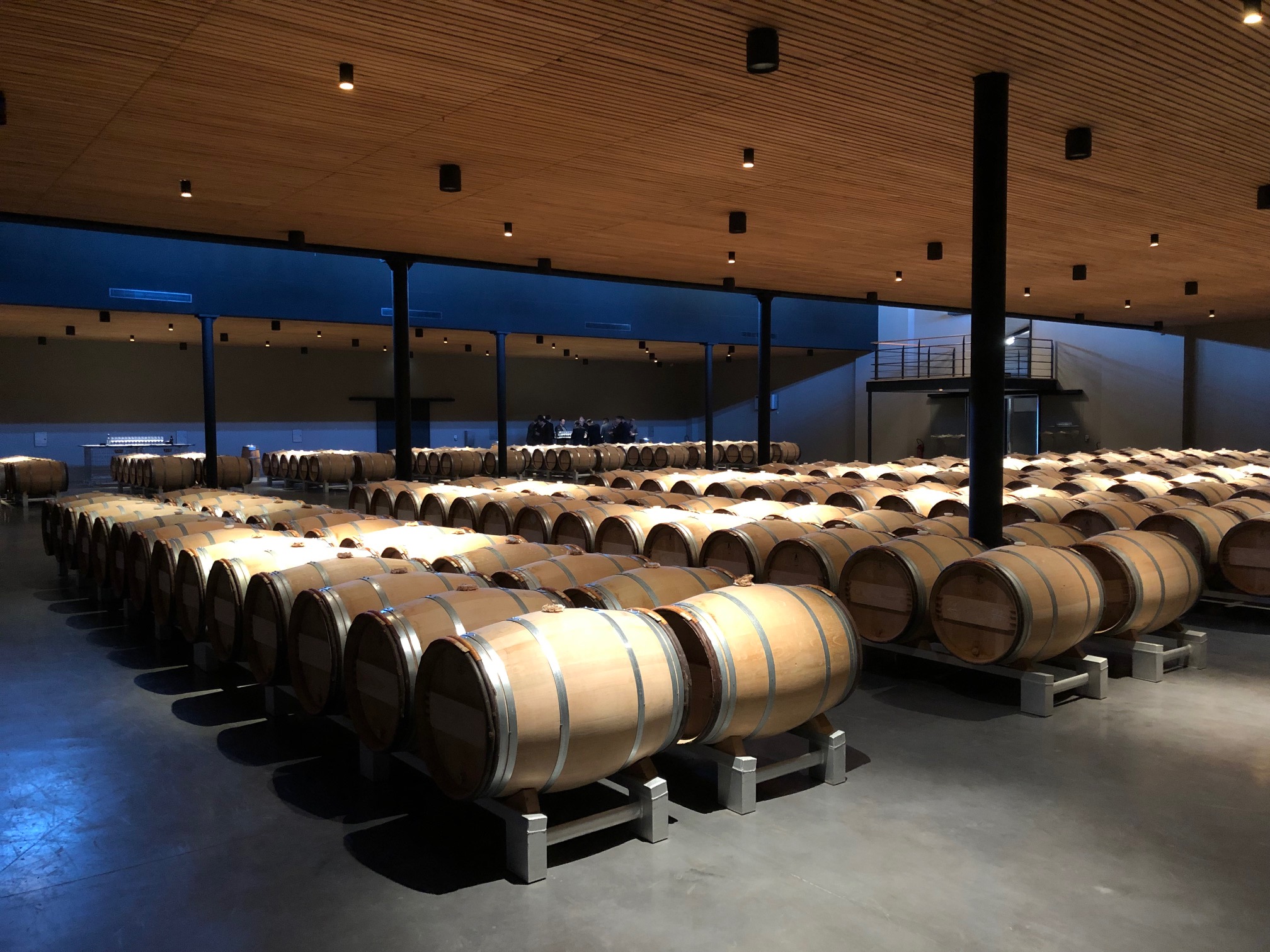 The cellar at biodynamic estate, Château Palmer, emptier than usual due to tiny production in 2018 following severe attacks of mildew.
The cellar at biodynamic estate, Château Palmer, emptier than usual due to tiny production in 2018 following severe attacks of mildew.
François-Xavier Borie, owner of Grand-Puy-Lacoste, believes that the real burning issue for en primeur is the volume released onto the market – or not. Some châteaux release nearly all their production, and others as little as 30%, keeping the rest back to create an artificial rarity in hope of selling the rest at a higher price later. Borie believes the right amount to release en primeur is “at least 80 percent,” cautioning that “releasing 30 percent and pretending it’s a real price is dangerous.”
Nicolas Ballarin of courtier Blanchy et de Lestapis agrees: “The problem of Bordeaux’s distribution is not in the price but in the fact that we don’t put enough wine into the market en primeur,” he states. “The real paradox is that knowing there’s none left at the château makes it more valued,” explains Ballarin, adding, “the négoce know they won’t get more.” He concludes that “prices only go up if there’s no more wine at the château.”
And after all, every producer’s objective is for their prices to go up. Many try to force this through their en primeur release price, while others let the market do the work. More than ever in 2018, there is no one-size-fits-all approach to bringing them onto the market.
As we saw in part I of our en primeur blog, 2018 was a vintage where producers’ decisions counted for a lot. In the words of Nicolas Glumineau, Managing Director of Pichon Comtesse, it is “a year with very important personal choices.” He was talking about the winemaking, but could just as easily be referring to the sale of the wine. “There won’t be any blanket tendencies,” says Frédéric Faye, Managing Director of Figeac, underlining that, “each château has to decide for itself and not look at its neighbours.”
Pricing
The only golden rule that the trade seem to agree on is that the 2018s should not be priced higher than the 2016s were upon release. “It would be a massive mistake for prices to be above those of 2016,” declared George Wilmoth, Head of Sales at UK merchant Justerini & Brooks. In Bordeaux, Edouard Moueix, Managing Director of Etablissements Jean-Pierre Moueix (producer and négociant), agrees, saying 2018 prices, “cannot be higher than 2016, it’s impossible.”
The exception to this rule of course, is where the 2016s have increased significantly since their release. Stephen Browett, Chairman of UK merchant Farr Vintners, reminds us that, “the vast majority of 2016 Bordeaux wines that customers bought en primeur are still available at delivery time at the same price as they paid two years ago, and in some cases less,” but there are exceptions, such as Lafleur, whose 2016 has increased 109% since release. When it released this morning, the château could therefore up its 2016 release price by 12% and still offer a 2018 that remains significantly cheaper than the current market price of the 2016.
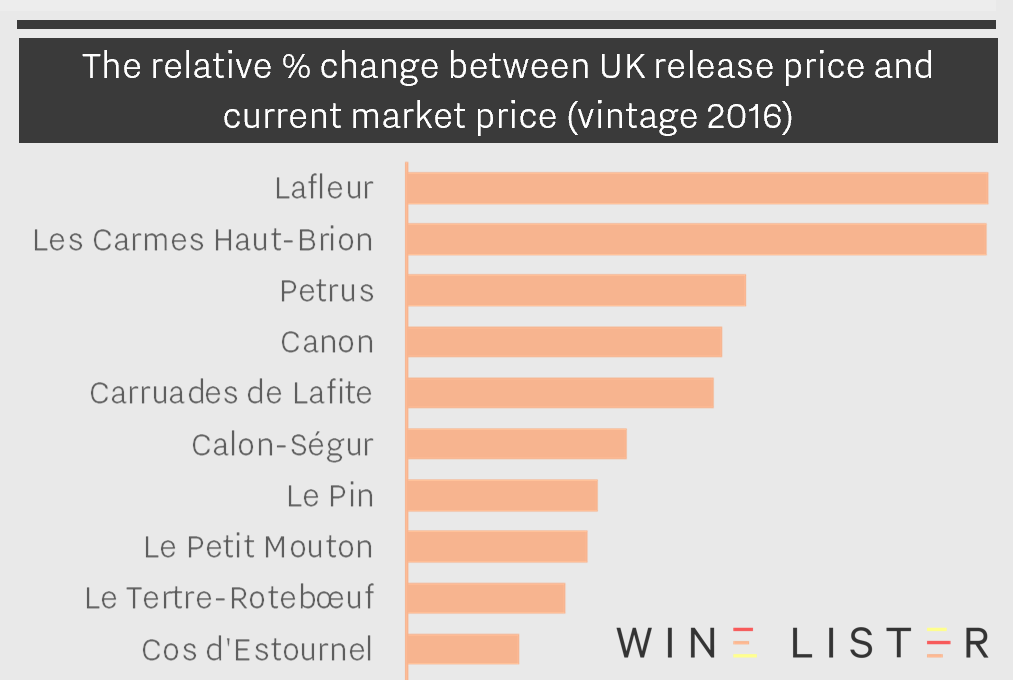 An excerpt from Wine Lister’s Bordeaux Study part I, showing the 10 2016 Bordeaux whose prices have increased the most since their release two years ago.
An excerpt from Wine Lister’s Bordeaux Study part I, showing the 10 2016 Bordeaux whose prices have increased the most since their release two years ago.
“At the end of the day the châteaux will charge what they can get,” states Mathieu Chadronnier, MD of négociant CVBG. The allocation system in Bordeaux means this is often more than what they should arguably be charging, because négociants don’t want to risk losing share to competitors in future years. However, some did refuse allocations in last year’s campaign, and this could happen again – and maybe on a larger scale – if prices are too ambitious.So far there have only been small instances of this.
Timing
The campaign is a precocious one, with Angélus releasing on 16th April, and a few dozen releases since, including well-known names Branaire-Ducru, Langoa-Barton, and Labégorce. However, it doesn’t really seem to have got going. Some of the Wine Lister team is just back from two days in Bordeaux speaking with négociants and courtiers on the Place, and there is a distinct lack of energy so far.
However, after yesterday’s bank holiday in France, and a handful of releases today, things are set to pick up pace in earnest next week. We expect a series of releases from châteaux that have historically judged their en primeur prices well, and this could breathe some life into the campaign. On the other hand, these are the very same châteaux who can actually conceive of increasing their prices, given their market value has risen sufficiently.
Some fear this will set the wrong precedent for their neighbours, which is why it is more important than ever for each property to consider its pricing strategy in the context of its own performance, and not what its neighbours are doing. Châteaux need to “make sure that their en primeur price to the consumer is lower than that of older vintages,” says Browett. In part I of our recent Bordeaux study, we looked at a case study of a hot property in Bordeaux that did just that in last year’s campaign.
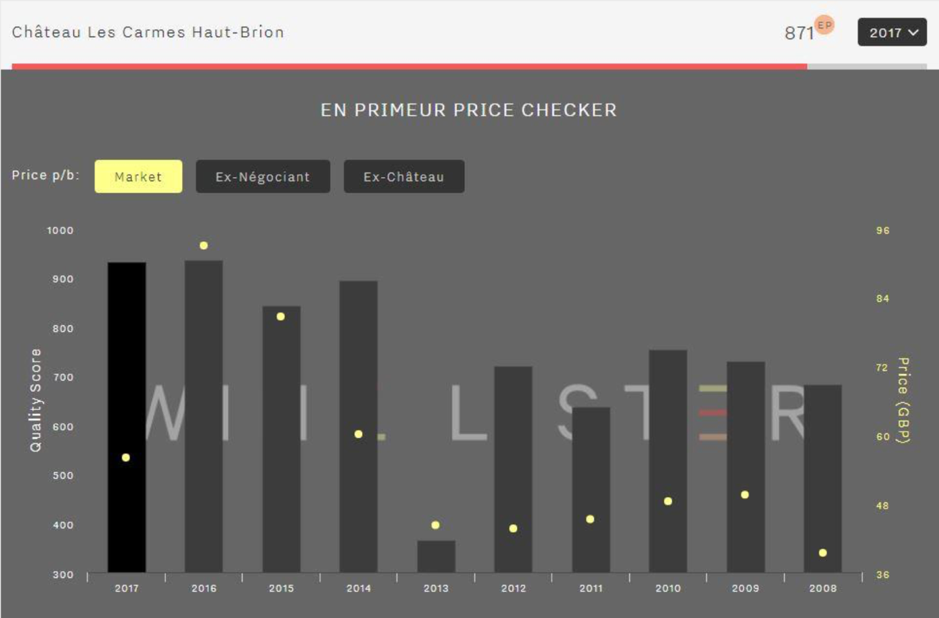 A masterclass in en primeur release pricing – the chart above shows Carmes Haut Brion’s 2017 release prices versus previous vintages on its day of release last year. Today the market price of 2017 is £65 (16% above release), and the 2016, £133 (109% above release).
A masterclass in en primeur release pricing – the chart above shows Carmes Haut Brion’s 2017 release prices versus previous vintages on its day of release last year. Today the market price of 2017 is £65 (16% above release), and the 2016, £133 (109% above release).
Let’s hope that more and more châteaux follow this formula as the campaign continues to unfold next week. The week after that is Vinexpo in Bordeaux, and most big-name releases will begin in earnest from 20th May.
Watch this space for the release of Wine Lister’s Bordeaux Study, Part II, before then.
In June 2018, the idea that Bordeaux had a very good vintage on its hands was laughable. The first half of the year had seen incessant rain in the region. Mildew was rife and vignerons were fighting it all day long, including at weekends (if they could afford to). At Château Corbin, owner Anabelle Cruse cancelled her trip to Vinexpo Hong Kong to be on site to manage treatments. “We couldn’t afford any mistakes after losing nearly all of the 2017 vintage [to frost],” she said.
But then on 18th June, the weather turned, and barely another drop of rain fell until September. 2018 was a year of extremes for Bordeaux. “It started hellish, and finished in ecstasy,” said Sara Lecompte Cuvelier, Managing Director at Léoville-Poyferré. “It started a nightmare and finished a dream,” echoed Guillaume Pouthier, Director at Carmes Haut-Brion.
Against all odds, some truly extraordinary wines were made. “Technically, it’s the most accomplished wine we have made since I joined,” said Nicolas Glumineau, Managing Director of Pichon Comtesse since 2012. Adrien Bernard declared, “the 2018 [red] is the greatest wine my dad has made” – the Bernard family bought Domaine de Chevalier in 1983. But 2018 was not a great vintage across the board like 1982, 1989, or 2010. It wasn’t a vintage where you could make a great wine with your eyes closed. On the contrary, 2018 is a vintage where human choices really mattered, and at the top level, happily, these choices were usually the right ones.
 Happy with their 2018s: Guillaume Pouthier, Pierre-Olivier Clouet, and Nicolas Glumineau
Happy with their 2018s: Guillaume Pouthier, Pierre-Olivier Clouet, and Nicolas Glumineau
Concentration in the 2018s is at unprecedented levels: grapes were lost to mildew in the spring, and then the summer drought left remaining berries very small, without much juice. Picking dates were key: the temptation to leave the grapes hanging in the Indian summer was strong, but success in 2018 was all about retaining freshness to counter the high levels of alcohol and tannin.
Even those who picked early were still facing unknown territory. Many producers recounted the topsy turvy ratio of marc to juice in the vats (more skins and pips than liquid). As a result, tannin levels were off the scale, with IPTs (Indice de Polyphénols Totaux) at their highest ever recorded for many producers. At Lynch-Bages, Technical Director Nicolas Labenne explained that, “a normal IPT would be 70, a good year is 80, and we’re at 95 in 2018.”
“But it’s the quality of the tannins that’s important,” Pouthier reminded us. This colossal potential needed taming by the winemakers if they were to make gentle giants, and not monsters in 2018. “This was a year where you couldn’t go into the cellar and say, ‘well every year I do it like this so I’ll do the same’,” said Lillian Barton. “You had to be careful with the extraction,” she explained.
During our tastings last week, producers of the best wines explained their use of more gentle, less frequent extraction, and vinification at lower temperatures than normal. At Petrus, winemaker Olivier Berrouet explained that, “In a hot vintage it’s tempting to go further, but we wanted to keep delicacy; we let the wine infuse like tea.” He was not the only one to talk about “infusion”, some châteaux foregoing altogether the use of extraction techniques such as pumping over and punching down. This allowed subtler winemakers to achieve silky, creamy tannins that melt in the mouth, while retaining all the generous flavours from the uniquely concentrated grapes.
The 2018 vintage really is one of a kind. “It’s impossible to compare it to another vintage other than to say 2016 plus plus,” offered Pierre Graffeuille, Managing Director at Léoville Las Cases, because it has “more of everything.” More alcohol, more tannin, more flavour, but also in the best examples (and there are many), more freshness and more silkiness (some of which have been highlighted in Wine Lister’s 2018 tasting favourites). So if you believe that more is more, this is a vintage for you. Just beware that some wines have all the beast and none of the beauty.
In part II of this en primeur round-up we will look at production volumes before considering the upcoming campaign – its context, as well as likely timing and pricing. Watch this space.
Part I of our annual Bordeaux study is available here, and part II will be released to subscribers in May. Follow us on Twitter for the 2018 Bordeaux en primeur release updates, or for real-time analysis enquire here about subscription to Wine Lister Pro.
Last week, members of the Wine Lister team were in Bordeaux tasting hundreds of Bordeaux 2018s en primeur. Our full report of the 2018 vintage (similar to last year’s article on 2017) will be out soon, and in the meantime we examine below some 2018 tasting highlights.
Quality across the wines we tasted is extremely high. We have selected 42 highlights, including 10 underdogs – those wines we felt surpassed our quality expectations.
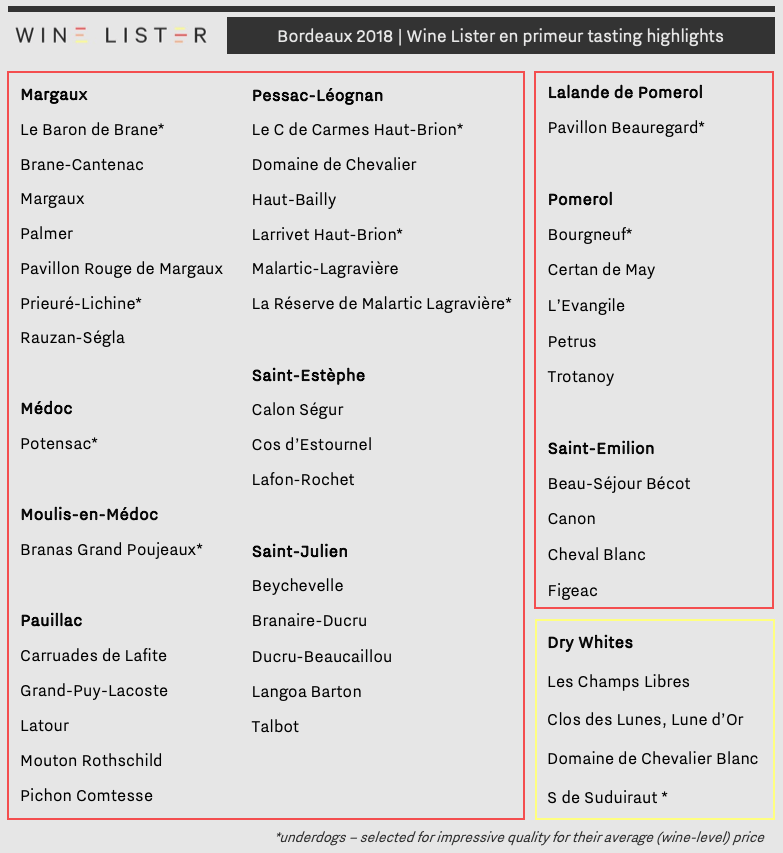
The Wine Lister team found beautiful wines in all the left bank appellations. Margaux and Pessac-Léognan appeared the most consistent for high quality, earning seven and six highlights respectively. These two appellations are home to five of Wine Lister’s 10 underdogs of 2018 en primeur tastings.
The former includes its first-growth namesake, Château Margaux, which was precise, addictive, and harmonious. Pavillon Rouge de Margaux also made the cut thanks to its intriguing and soft fruit character. Brane-Cantenac is becoming a Wine Lister staple after appearing in both 2016 and 2009 tasting highlights. Its 2018 was pure, fresh, and a perfect balance between power and finesse.
In Pessac-Léognan, Domaine de Chevalier had piercing intensity balanced with a floral softness, while Haut-Bailly impressed with a playful fruit character and velvet texture.
Elsewhere on the left bank, Branas Grand Poujeaux surprised with its classy, energetic, dark fruit. Pauillac produced examples of intense fruit handled with a delicate touch (Grand-Puy-Lacoste and Pichon Comtesse). Saint-Estèphe presented beguiling wines with great freshness and elegance (Cos d’Estournel). Saint-Julien showed depth of flavour and complexity in equal measure (Langoa Barton, Ducru-Beaucaillou).
The right bank was just as impressive, with an equal proportion of highlights for Wine Lister as the left (in each case, 19% of wines tasted made the cut). These include one underdog (and new discovery for Wine Lister) from Lalande de Pomerol, five stand-outs from Pomerol, and four from Saint-Émilion.
In Pomerol, Petrus was alluring, generous, and floral, while Trotanoy had delicate strength and never-ending energy. Saint-Émilion produced favourites of varying styles, including Cheval Blanc – a magical, mesmerising boudoir-style wine, and Canon – dancing, racy, and fresh.
Readers should note that these 42 wines are some of the team’s favourites from last week’s tastings, but that we will be releasing official Wine Lister Buys throughout the campaign as prices become known. WL Buys take into account a wine’s quality (based on our partner critics’ scores, which we look forward to adding as soon as they are released), and value within the vintage and appellation, as well as Wine Lister’s personal opinion based on our own tastings and market insights.
Trade members wishing to gain full access to Wine Lister’s en primeur campaign coverage will need to subscribe to Wine Lister Pro. Register your interest here.
Château Latour has released a parcel of their 2008 this morning. It is being offered in the UK at c.£425 per bottle. The factsheet below summarises its key points.

You can download this slide here: Château Latour 2008
Wine Lister recently analysed the Bordeaux 2009 vintage in two parts. The first – a tasting and subsequent selection of top picks by Wine Lister’s founder, Ella Lister, revealed sublime quality across both banks. The second – a two-page analysis of the vintage overall – reveals that alongside top quality, prices of Bordeaux 2009s are high, and it is therefore all the more difficult to find good value, particularly among the left bank’s classified growths.
With this in mind, our Listed: top five blog this week explores the highest-quality Bordeaux fifth growths from the 2009 vintage. Despite the great quality across appellations, all five hail from Pauillac. They are all also Wine Lister Buzz Brands.
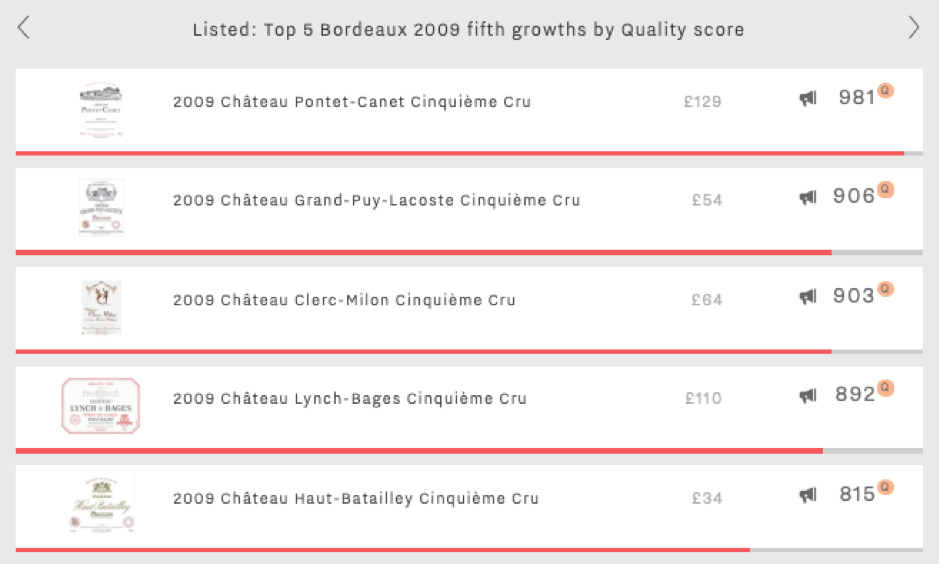
In first place is Pontet-Canet 2009. Its Quality score of 981 sits a full 102 points above the average of the other four wines in this week’s top five. This presumably contributes to its price of £129 per bottle in-bond – the highest of the group.
Next is Grand-Puy-Lacoste 2009, with a Quality score of 906 and the second-lowest price of this week’s top five (£54 per bottle in-bond). It is the only one of the group to appear among top picks from the recent 2009 re-tasting.
Just three points behind Grand-Puy-Lacoste, in third place, is Clerc-Milon 2009. In the economics department it outperforms the rest of the group significantly, with an Economics score of 905 and a compound annual growth rate (CAGR) of 17.3% – over two and a half times higher than the average of the other four wines in this week’s top five.
This week’s last two wines now fall under the same ownership, that of the Cazes Family. Nonetheless, the 2009 vintages of Lynch-Bages and Haut-Batailley, which achieve Quality scores of 892 and 815 respectively, present quite different profiles. Lynch-Bages is this week’s “brand king” with a Brand score of 996 – the highest of this week’s top five – and a price of £110 per bottle in-bond. Though Haut-Batailley 2009 achieves a Quality score 7% lower than Lynch-Bages, its price of £34 is 69% lower than that of its sibling, therefore providing exceptional value. After the acquisition and subsequent repositioning of Haut-Batailley through its 2017 en primeur release, it will be interesting to see how both châteaux fare in the upcoming 2018 campaign.
Wine Lister is experiencing a touch of Bordeaux fever. Having re-tasted Bordeaux 2016s in January, Wine Lister’s founder, Ella, attended BI Wines’ “10 years on” tasting last week, revisiting the iconic 2009 vintage.
As expected, the vintage yielded some truly exceptional wines, thanks to excellent weather conditions, especially around harvest time. However, some producers fell into the trap of waiting too long to pick, and high quality in 2009 is not a given. Ella has picked out 26 of the most successful examples of a unique and pleasure-giving vintage, hailing from across all of the best-known red wine Bordeaux appellations (N.B. no white wines were tasted).
The most heterogenous appellation was Saint-Emilion, with some wines rendered hot and hard by high alcohol, while those at the very top level were some of the best 2009s out there. Cheval Blanc, for example, achieved a “mystical, beguiling bouquet…like a magic potion”.
Pomerol did not seem to suffer from the heat in the same way, and made beautiful wines in 2009. Perhaps unsurprisingly, Le Pin garnered some exceptional comments, including “the richest, most decadent, abundant nose of the whole tasting”. Other Pomerol picks displayed an unusually dark-fruited character. Petrus (“not worn on the sleeve like the Le Pin”), had a “refined dark fruit character”, Hosanna “piercing damson fruit”, and La Conseillante boasted a “carnal, purple-fruit sweetness”.
On the left bank, Pessac-Léognan and Saint-Julien achieve joint-first place, earning five highlights each. Arguably the most impressive of these were La Mission Haut-Brion and Haut-Brion with the former described as “sensual, ethereal, and breath-taking”. Pape Clément showed almost “Rhône-esque animality”, while Malartic-Lagravière was “opulent” and “left you wanting more”.
Saint-Julien presented expected names – second growths Gruaud-Larose and Léoville Barton (described as “ultra-classical” and “thoroughbred” respectively), as well as a surprise in the form of Château Gloria, the only Cru Bourgeois to make it into this list of Bordeaux 2009 tasting highlights.
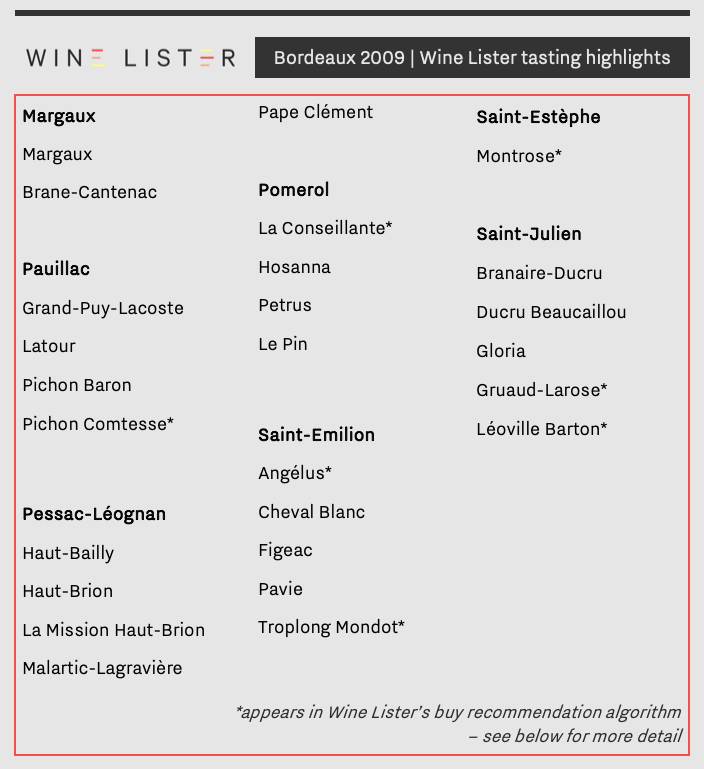
The remaining left bank appellations did not go wanting of favourites. Latour earned the comment, “impeccably turned-out, this wine demands attention”. Elsewhere in Pauillac Pichon Comtesse was “beguiling” and “gradually confident”.
In Margaux the appellation’s first growth namesake was hailed “quite the showstopper”, while Brane-Cantenac was “lifted, lovely, and luminous”. While Saint-Estèphe earned only one mention, its representative, Montrose surpassed expectation, appearing “supremely poised”.
All those wines marked “*” above currently qualify as Wine Lister “buy recommendations”. The Wine Lister team has been working hard to create a data-driven list of the ultimate best wines to buy – watch this space while we fine-tune the algorithm!
Other wines featuring in the Bordeaux 2009 highlights are: Grand-Puy-Lacoste, Pichon Baron, Haut-Bailly, Angélus, Figeac, Pavie, Troplong Mondot, Branaire-Ducru, and Ducru Beaucaillou.
Yesterday marked the annual BI Fine Wines’ 10 years on tasting, this year focusing on the iconic Bordeaux 2009s. Below we explore what light Wine Lister data has to shed on the 2009 vintage including quality, price performance, and best wines for good value.
Wine Lister’s holistic and dynamic approach allows us to not only see which appellations produced the vintage’s best wines, but also demonstrates if and how the market has since reacted to their relative quality.
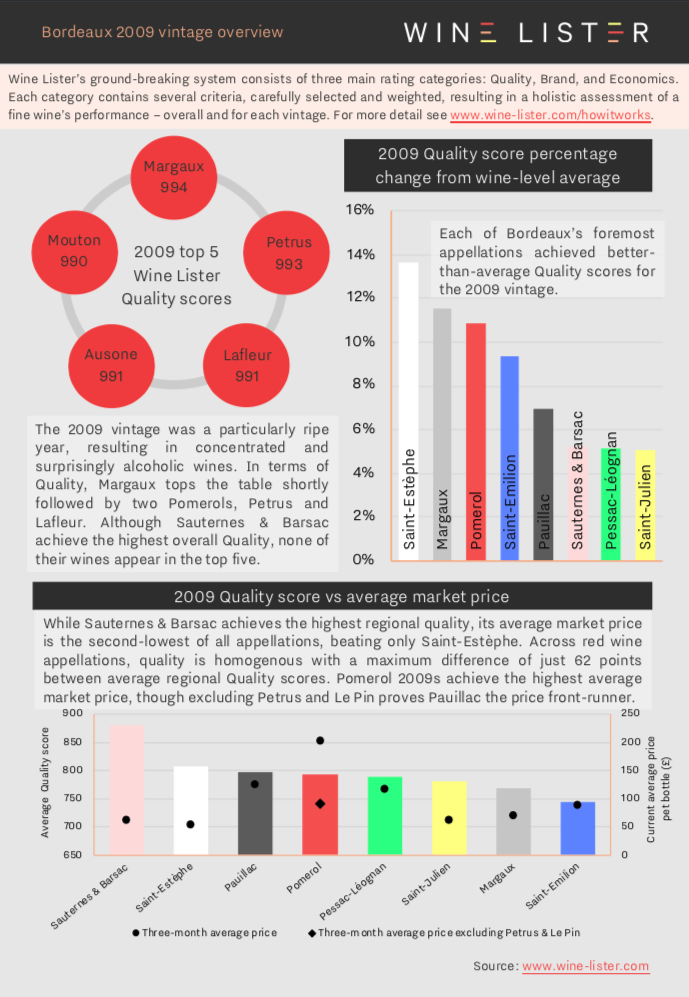

You can download the slides here: Wine Lister Bordeaux 2009 vintage overview
Featured wines: Margaux, Petrus, Lafleur, Ausone, Mouton, Capbern, Lilian Ladouys, Couhins-Lurton, Fourcas Hosten, Guillot Clauzel, Clos Saint-Martin, Lynsolence, La Cabanne, and Pavillon Rouge.
Yesterday we examined Wine Lister founder, Ella Lister’s top left bank picks from the recent re-tasting of 204 Bordeaux 2016s, now in bottle.
Almost as many wines stood out across appellations on the right bank, from a tasting the following day of 171 wines – testament to the fantastic quality available across the board in 2016. There is no doubting 2016 is a great vintage in Bordeaux. Tasting these wines from bottle only served to confirm the Wine Lister team’s enthusiasm during en primeur tastings in the spring of 2017. Revisit our blog post from the time for details of the unusual weather conditions behind this vintage.
Wine Lister right bank highlights include 11 Saint-Emilion wines vs. 10 in Pomerol, and the top pick overall was Figeac, which was “intellectual”, “fine-boned” and “gourmand”.
Several of its well-known Saint-Emilion neighbours also made the cut into Wine Lister tasting highlights, including Canon ( “feather-light, but generous”), Clos Fourtet, and La Gaffelière.
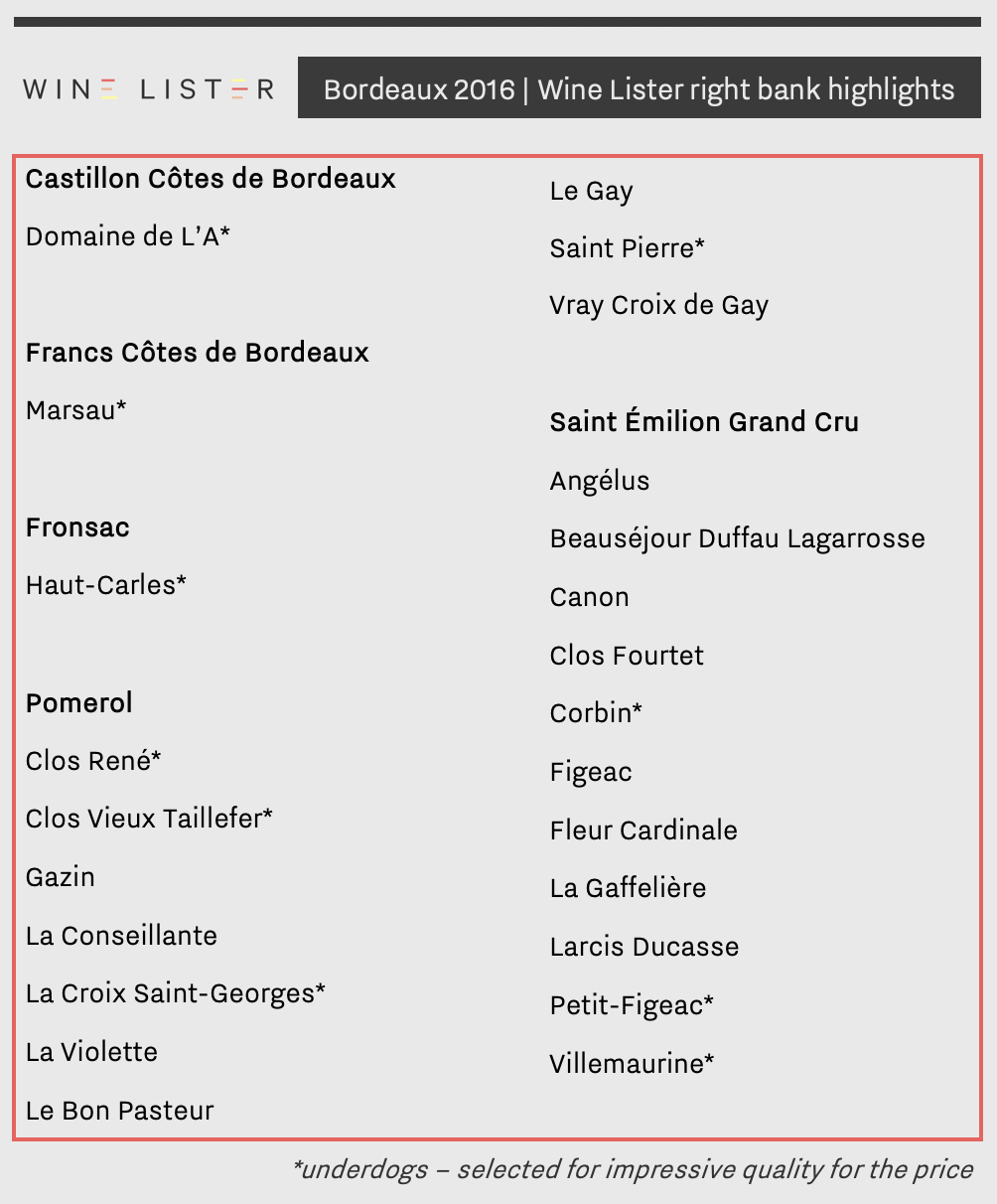 N.B. The tasting did not include wines such as Petrus, Le Pin, Vieux Château Certan, Trotanoy, Ausone, Cheval Blanc, or Pavie.
N.B. The tasting did not include wines such as Petrus, Le Pin, Vieux Château Certan, Trotanoy, Ausone, Cheval Blanc, or Pavie.
However, it was Pomerol that produced more “underdogs” than its neighbour: not-so-big names punching above their weight. Of particular note were Clos Vieux Taillefer and La Croix Saint-Georges.
Among Pomerol top dogs, La Violette was showing beautifully, with a “delicate, fresh” nose and “unctuous, satin” palate. Vray Croix de Gay was “refined” and “thoroughbred”, while La Conseillante produced a “gorgeous, fine-grained texture”.
Further afield, Domaine de l’A from the Côtes de Castillon impressed, as did Marsau, from Francs Côtes de Bordeaux.
Also included in Bordeaux 2016 right bank picks were: Gazin, Saint Pierre, Le Gay, Beauséjour Heritiers Duffau Lagarrosse, Larcis Ducasse, Angélus, Villemaurine, Fleur Cardinale, Clos René, Corbin, and Petit Figeac.


 The cellar at biodynamic estate, Château Palmer, emptier than usual due to tiny production in 2018 following severe attacks of mildew.
The cellar at biodynamic estate, Château Palmer, emptier than usual due to tiny production in 2018 following severe attacks of mildew. An excerpt from Wine Lister’s Bordeaux Study part I, showing the 10 2016 Bordeaux whose prices have increased the most since their release two years ago.
An excerpt from Wine Lister’s Bordeaux Study part I, showing the 10 2016 Bordeaux whose prices have increased the most since their release two years ago. A masterclass in en primeur release pricing – the chart above shows Carmes Haut Brion’s 2017 release prices versus previous vintages on its day of release last year. Today the market price of 2017 is £65 (16% above release), and the 2016, £133 (109% above release).
A masterclass in en primeur release pricing – the chart above shows Carmes Haut Brion’s 2017 release prices versus previous vintages on its day of release last year. Today the market price of 2017 is £65 (16% above release), and the 2016, £133 (109% above release). Happy with their 2018s: Guillaume Pouthier, Pierre-Olivier Clouet, and Nicolas Glumineau
Happy with their 2018s: Guillaume Pouthier, Pierre-Olivier Clouet, and Nicolas Glumineau





 N.B. The tasting did not include wines such as Petrus, Le Pin, Vieux Château Certan, Trotanoy, Ausone, Cheval Blanc, or Pavie.
N.B. The tasting did not include wines such as Petrus, Le Pin, Vieux Château Certan, Trotanoy, Ausone, Cheval Blanc, or Pavie.